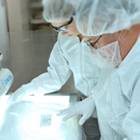INTEGRATED+DNA+TECHNOLOGIE
Artikel-Nr:
(BOSSBS-9647R-A647)
Lieferant:
Bioss
Hersteller-Artikelnummer::
BS-9647R-A647
Lokale Artikelnummer::
BOSSBS-9647R-A647
Beschreibung:
C17orf77 is a 243 amino acid protein that is encoded by a gene mapping to human chromosome 17. Chromosome 17 makes up over 2.5% of the human genome with about 81 million bases encoding over 1,200 genes. Two key tumor suppressor genes are associated with chromosome 17, namely, p53 and BRCA1. Tumor suppressor p53 is necessary for maintenance of cellular genetic integrity by moderating cell fate through DNA repair versus cell death. Malfunction or loss of p53 expression is associated with malignant cell growth and Li-Fraumeni syndrome. Like p53, BRCA1 is directly involved in DNA repair, specifically it is recognized as a genetic determinant of early onset breast cancer and predisposition to cancers of the ovary, colon, prostate gland and fallopian tubes. Chromosome 17 is also linked to neurofibromatosis, a condition characterized by neural and epidermal lesions, and dysregulated Schwann cell growth. Alexander disease, Birt-Hogg-Dube syndrome and Canavan disease are also associated with chromosome 17.
VE:
1 * 100 µl
Artikel-Nr:
(BOSSBS-13685R-FITC)
Lieferant:
Bioss
Hersteller-Artikelnummer::
BS-13685R-FITC
Lokale Artikelnummer::
BOSSBS-13685R-FITC
Beschreibung:
C17orf87 (chromosome 17 open reading frame 87) is a 145 amino acid protein that is encoded by a gene mapping to human chromosome 17. Chromosome 17 makes up over 2.5% of the human genome with about 81 million bases encoding over 1,200 genes. Two key tumor suppressor genes are associated with chromosome 17, namely, p53 and BRCA1. Tumor suppressor p53 is necessary for maintenance of cellular genetic integrity by moderating cell fate through DNA repair versus cell death. Malfunction or loss of p53 expression is associated with malignant cell growth and Li-Fraumeni syndrome. Like p53, BRCA1 is directly involved in DNA repair, specifically it is recognized as a genetic determinant of early onset breast cancer and predisposition to cancers of the ovary, colon, prostate gland and fallopian tubes. Chromosome 17 is also linked to neurofibromatosis, a condition characterized by neural and epidermal lesions, and dysregulated Schwann cell growth. Alexander disease, Birt-Hogg-Dube syndrome and Canavan disease are also associated with chromosome 17.
VE:
1 * 100 µl
Artikel-Nr:
(BOSSBS-9639R)
Lieferant:
Bioss
Hersteller-Artikelnummer::
BS-9639R
Lokale Artikelnummer::
BOSSBS-9639R
Beschreibung:
C17orf42 is a 360 amino acid protein that exists as two alternatively spliced isoforms and is encoded by a gene mapping to human chromosome 17. Chromosome 17 makes up over 2.5% of the human genome with about 81 million bases encoding over 1,200 genes. Two key tumor suppressor genes are associated with chromosome 17, namely, p53 and BRCA1. Tumor suppressor p53 is necessary for maintenance of cellular genetic integrity by moderating cell fate through DNA repair versus cell death. Malfunction or loss of p53 expression is associated with malignant cell growth and Li-Fraumeni syndrome. Like p53, BRCA1 is directly involved in DNA repair, specifically it is recognized as a genetic determinant of early onset breast cancer and predisposition to cancers of the ovary, colon, prostate gland and fallopian tubes. Chromosome 17 is also linked to neurofibromatosis, a condition characterized by neural and epidermal lesions, and dysregulated Schwann cell growth. Alexander disease, Birt-Hogg-Dube syndrome and Canavan disease are also associated with chromosome 17.
VE:
1 * 100 µl
Artikel-Nr:
(BOSSBS-9419R)
Lieferant:
Bioss
Hersteller-Artikelnummer::
BS-9419R
Lokale Artikelnummer::
BOSSBS-9419R
Beschreibung:
The tetraspanins are integral membrane proteins expressed on cell surface and granular membranes of hematopoietic cells and are components of multi-molecular complexes with specific integrins. Oculospanin, also known as tetraspanin 10 (TSPAN10) or OCSP, is a 355 amino acid multi-pass membrane protein belonging to the tetraspanin (TM4SF) family. Oculospanin is expressed in certain regions of the eye such as retinal pigment epithelium, ciliary body and iris, but is not found in the lens. The gene encoding Oculospanin maps to human chromosome 17, which comprises over 2.5% of the human genome and encodes over 1,200 genes. Two key tumor suppressor genes are associated with chromosome 17, namely, p53 and BRCA1. Malfunction or loss of p53 expression is associated with malignant cell growth and Li-Fraumeni syndrome. Like p53, BRCA1 is directly involved in DNA repair, and is liked to predisposition of cancers of the ovary, colon, prostate gland and fallopian tubes.
VE:
1 * 100 µl
Artikel-Nr:
(BOSSBS-8132R-A488)
Lieferant:
Bioss
Hersteller-Artikelnummer::
BS-8132R-A488
Lokale Artikelnummer::
BOSSBS-8132R-A488
Beschreibung:
The coiled-coil domain is a structural motif found in proteins that are involved in a diverse array of biological functions such as the regulation of gene expression, cell division, membrane fusion and drug extrusion and delivery. CCDC43 (coiled-coil domain containing 43) is a 224 amino acid protein encoded by a gene that maps to human chromosome 17q21.31. Encoding over 1,200 genes, chromosome 17 comprises over 2.5% of the human genome. Two key tumor suppressor genes are associated with chromosome 17, namely, p53 and BRCA1. Tumor suppressor p53 is necessary for maintenance of cellular genetic integrity by moderating cell fate through DNA repair versus cell death. Malfunction or loss of p53 expression is associated with malignant cell growth and Li-Fraumeni syndrome.
VE:
1 * 100 µl
Artikel-Nr:
(BOSSBS-8131R-A350)
Lieferant:
Bioss
Hersteller-Artikelnummer::
BS-8131R-A350
Lokale Artikelnummer::
BOSSBS-8131R-A350
Beschreibung:
The coiled-coil domain is a structural motif found in proteins that are involved in a diverse array of biological functions such as the regulation of gene expression, cell division, membrane fusion and drug extrusion and delivery. CCDC42 (coiled-coil domain containing 42) is a 316 amino acid protein encoded by a gene that maps to human chromosome 17p13.1. Encoding over 1,200 genes, chromosome 17 comprises over 2.5% of the human genome. Two key tumor suppressor genes are associated with chromosome 17, namely, p53 and BRCA1. Tumor suppressor p53 is necessary for maintenance of cellular genetic integrity by moderating cell fate through DNA repair versus cell death. Malfunction or loss of p53 expression is associated with malignant cell growth and Li-Fraumeni syndrome.
VE:
1 * 100 µl
Artikel-Nr:
(BOSSBS-8131R-CY5.5)
Lieferant:
Bioss
Hersteller-Artikelnummer::
BS-8131R-CY5.5
Lokale Artikelnummer::
BOSSBS-8131R-CY5.5
Beschreibung:
The coiled-coil domain is a structural motif found in proteins that are involved in a diverse array of biological functions such as the regulation of gene expression, cell division, membrane fusion and drug extrusion and delivery. CCDC42 (coiled-coil domain containing 42) is a 316 amino acid protein encoded by a gene that maps to human chromosome 17p13.1. Encoding over 1,200 genes, chromosome 17 comprises over 2.5% of the human genome. Two key tumor suppressor genes are associated with chromosome 17, namely, p53 and BRCA1. Tumor suppressor p53 is necessary for maintenance of cellular genetic integrity by moderating cell fate through DNA repair versus cell death. Malfunction or loss of p53 expression is associated with malignant cell growth and Li-Fraumeni syndrome.
VE:
1 * 100 µl
Artikel-Nr:
(BOSSBS-8131R-CY7)
Lieferant:
Bioss
Hersteller-Artikelnummer::
BS-8131R-CY7
Lokale Artikelnummer::
BOSSBS-8131R-CY7
Beschreibung:
The coiled-coil domain is a structural motif found in proteins that are involved in a diverse array of biological functions such as the regulation of gene expression, cell division, membrane fusion and drug extrusion and delivery. CCDC42 (coiled-coil domain containing 42) is a 316 amino acid protein encoded by a gene that maps to human chromosome 17p13.1. Encoding over 1,200 genes, chromosome 17 comprises over 2.5% of the human genome. Two key tumor suppressor genes are associated with chromosome 17, namely, p53 and BRCA1. Tumor suppressor p53 is necessary for maintenance of cellular genetic integrity by moderating cell fate through DNA repair versus cell death. Malfunction or loss of p53 expression is associated with malignant cell growth and Li-Fraumeni syndrome.
VE:
1 * 100 µl
Artikel-Nr:
(BOSSBS-8132R-A555)
Lieferant:
Bioss
Hersteller-Artikelnummer::
BS-8132R-A555
Lokale Artikelnummer::
BOSSBS-8132R-A555
Beschreibung:
The coiled-coil domain is a structural motif found in proteins that are involved in a diverse array of biological functions such as the regulation of gene expression, cell division, membrane fusion and drug extrusion and delivery. CCDC43 (coiled-coil domain containing 43) is a 224 amino acid protein encoded by a gene that maps to human chromosome 17q21.31. Encoding over 1,200 genes, chromosome 17 comprises over 2.5% of the human genome. Two key tumor suppressor genes are associated with chromosome 17, namely, p53 and BRCA1. Tumor suppressor p53 is necessary for maintenance of cellular genetic integrity by moderating cell fate through DNA repair versus cell death. Malfunction or loss of p53 expression is associated with malignant cell growth and Li-Fraumeni syndrome.
VE:
1 * 100 µl
Artikel-Nr:
(BOSSBS-8671R-A680)
Lieferant:
Bioss
Hersteller-Artikelnummer::
BS-8671R-A680
Lokale Artikelnummer::
BOSSBS-8671R-A680
Beschreibung:
Key component of the cytosolic iron-sulfur protein assembly (CIA) complex, a multiprotein complex that mediates the incorporation of iron-sulfur cluster into apoproteins specifically involved in DNA metabolism and genomic integrity. In the CIA complex, MMS19 acts as an adapter between early-acting CIA components and a subset of cellular target iron-sulfur proteins such as ERCC2/XPD, FANCJ and RTEL1, thereby playing a key role in nucleotide excision repair (NER) and RNA polymerase II (POL II) transcription. As part of the mitotic spindle-associated MMXD complex, plays a role in chromosome segregation, probably by facilitating iron-sulfur cluster assembly into ERCC2/XPD. Indirectly acts as a transcriptional coactivator of estrogen receptor (ER), via its role in iron-sulfur insertion into some component of the TFIIH-machinery.
VE:
1 * 100 µl
Artikel-Nr:
(BOSSBS-11693R-A555)
Lieferant:
Bioss
Hersteller-Artikelnummer::
BS-11693R-A555
Lokale Artikelnummer::
BOSSBS-11693R-A555
Beschreibung:
Probable RNA/DNA helicase involved in diverse aspects of RNA metabolism and genomic integrity. Plays a role in transcription regulation by its ability to modulate RNA Polymerase II (Pol II) binding to chromatin and through its interaction with proteins involved in transcription (PubMed:19515850, PubMed:21700224). Contributes to the mRNA splicing efficiency and splice site selection (PubMed:19515850). Required for the resolution of R-loop RNA-DNA hybrid formation at G-rich pause sites located downstream of the poly(A) site, allowing XRN2 recruitment and XRN2-mediated degradation of the downstream cleaved RNA and hence efficient RNA polymerase II (RNAp II) transcription termination (PubMed:19515850, PubMed:21700224). Required for the 3' transcriptional termination of PER1 and CRY2, thus playing an important role in the circadian rhythm regulation (By similarity). Involved in DNA double-strand breaks damage response generated by oxidative stress (PubMed:17562789). In association with RRP45, targets the RNA exosome complex to sites of transcription-induced DNA damage (PubMed:24105744). Plays a role in the development and maturation of germ cells: essential for male meiosis, acting at the interface of transcription and meiotic recombination, and in the process of gene silencing during meiotic sex chromosome inactivation (MSCI) (By similarity). May be involved in telomeric stability through the regulation of telomere repeat-containing RNA (TERRA) transcription (PubMed:21112256). Plays a role in neurite outgrowth in hippocampal cells through FGF8-activated signaling pathways. Inhibits retinoic acid-induced apoptosis (PubMed:21576111).
VE:
1 * 100 µl
Artikel-Nr:
(BOSSBS-11693R-CY7)
Lieferant:
Bioss
Hersteller-Artikelnummer::
BS-11693R-CY7
Lokale Artikelnummer::
BOSSBS-11693R-CY7
Beschreibung:
Probable RNA/DNA helicase involved in diverse aspects of RNA metabolism and genomic integrity. Plays a role in transcription regulation by its ability to modulate RNA Polymerase II (Pol II) binding to chromatin and through its interaction with proteins involved in transcription (PubMed:19515850, PubMed:21700224). Contributes to the mRNA splicing efficiency and splice site selection (PubMed:19515850). Required for the resolution of R-loop RNA-DNA hybrid formation at G-rich pause sites located downstream of the poly(A) site, allowing XRN2 recruitment and XRN2-mediated degradation of the downstream cleaved RNA and hence efficient RNA polymerase II (RNAp II) transcription termination (PubMed:19515850, PubMed:21700224). Required for the 3' transcriptional termination of PER1 and CRY2, thus playing an important role in the circadian rhythm regulation (By similarity). Involved in DNA double-strand breaks damage response generated by oxidative stress (PubMed:17562789). In association with RRP45, targets the RNA exosome complex to sites of transcription-induced DNA damage (PubMed:24105744). Plays a role in the development and maturation of germ cells: essential for male meiosis, acting at the interface of transcription and meiotic recombination, and in the process of gene silencing during meiotic sex chromosome inactivation (MSCI) (By similarity). May be involved in telomeric stability through the regulation of telomere repeat-containing RNA (TERRA) transcription (PubMed:21112256). Plays a role in neurite outgrowth in hippocampal cells through FGF8-activated signaling pathways. Inhibits retinoic acid-induced apoptosis (PubMed:21576111).
VE:
1 * 100 µl
Artikel-Nr:
(BOSSBS-11693R-A647)
Lieferant:
Bioss
Hersteller-Artikelnummer::
BS-11693R-A647
Lokale Artikelnummer::
BOSSBS-11693R-A647
Beschreibung:
Probable RNA/DNA helicase involved in diverse aspects of RNA metabolism and genomic integrity. Plays a role in transcription regulation by its ability to modulate RNA Polymerase II (Pol II) binding to chromatin and through its interaction with proteins involved in transcription (PubMed:19515850, PubMed:21700224). Contributes to the mRNA splicing efficiency and splice site selection (PubMed:19515850). Required for the resolution of R-loop RNA-DNA hybrid formation at G-rich pause sites located downstream of the poly(A) site, allowing XRN2 recruitment and XRN2-mediated degradation of the downstream cleaved RNA and hence efficient RNA polymerase II (RNAp II) transcription termination (PubMed:19515850, PubMed:21700224). Required for the 3' transcriptional termination of PER1 and CRY2, thus playing an important role in the circadian rhythm regulation (By similarity). Involved in DNA double-strand breaks damage response generated by oxidative stress (PubMed:17562789). In association with RRP45, targets the RNA exosome complex to sites of transcription-induced DNA damage (PubMed:24105744). Plays a role in the development and maturation of germ cells: essential for male meiosis, acting at the interface of transcription and meiotic recombination, and in the process of gene silencing during meiotic sex chromosome inactivation (MSCI) (By similarity). May be involved in telomeric stability through the regulation of telomere repeat-containing RNA (TERRA) transcription (PubMed:21112256). Plays a role in neurite outgrowth in hippocampal cells through FGF8-activated signaling pathways. Inhibits retinoic acid-induced apoptosis (PubMed:21576111).
VE:
1 * 100 µl
Artikel-Nr:
(BOSSBS-8671R)
Lieferant:
Bioss
Hersteller-Artikelnummer::
BS-8671R
Lokale Artikelnummer::
BOSSBS-8671R
Beschreibung:
Key component of the cytosolic iron-sulfur protein assembly (CIA) complex, a multiprotein complex that mediates the incorporation of iron-sulfur cluster into apoproteins specifically involved in DNA metabolism and genomic integrity. In the CIA complex, MMS19 acts as an adapter between early-acting CIA components and a subset of cellular target iron-sulfur proteins such as ERCC2/XPD, FANCJ and RTEL1, thereby playing a key role in nucleotide excision repair (NER) and RNA polymerase II (POL II) transcription. As part of the mitotic spindle-associated MMXD complex, plays a role in chromosome segregation, probably by facilitating iron-sulfur cluster assembly into ERCC2/XPD. Indirectly acts as a transcriptional coactivator of estrogen receptor (ER), via its role in iron-sulfur insertion into some component of the TFIIH-machinery.
VE:
1 * 100 µl
Artikel-Nr:
(BOSSBS-8132R-CY3)
Lieferant:
Bioss
Hersteller-Artikelnummer::
BS-8132R-CY3
Lokale Artikelnummer::
BOSSBS-8132R-CY3
Beschreibung:
The coiled-coil domain is a structural motif found in proteins that are involved in a diverse array of biological functions such as the regulation of gene expression, cell division, membrane fusion and drug extrusion and delivery. CCDC43 (coiled-coil domain containing 43) is a 224 amino acid protein encoded by a gene that maps to human chromosome 17q21.31. Encoding over 1,200 genes, chromosome 17 comprises over 2.5% of the human genome. Two key tumor suppressor genes are associated with chromosome 17, namely, p53 and BRCA1. Tumor suppressor p53 is necessary for maintenance of cellular genetic integrity by moderating cell fate through DNA repair versus cell death. Malfunction or loss of p53 expression is associated with malignant cell growth and Li-Fraumeni syndrome.
VE:
1 * 100 µl
Artikel-Nr:
(BOSSBS-8132R-CY5.5)
Lieferant:
Bioss
Hersteller-Artikelnummer::
BS-8132R-CY5.5
Lokale Artikelnummer::
BOSSBS-8132R-CY5.5
Beschreibung:
The coiled-coil domain is a structural motif found in proteins that are involved in a diverse array of biological functions such as the regulation of gene expression, cell division, membrane fusion and drug extrusion and delivery. CCDC43 (coiled-coil domain containing 43) is a 224 amino acid protein encoded by a gene that maps to human chromosome 17q21.31. Encoding over 1,200 genes, chromosome 17 comprises over 2.5% of the human genome. Two key tumor suppressor genes are associated with chromosome 17, namely, p53 and BRCA1. Tumor suppressor p53 is necessary for maintenance of cellular genetic integrity by moderating cell fate through DNA repair versus cell death. Malfunction or loss of p53 expression is associated with malignant cell growth and Li-Fraumeni syndrome.
VE:
1 * 100 µl
Preis auf Anfrage
Lager für diesen Artikel ist begrenzt, kann aber in einem Lagerhaus in Ihrer Nähe zur Verfügung. Bitte stellen Sie sicher, dass Sie in sind angemeldet auf dieser Seite, so dass verfügbare Bestand angezeigt werden können. Wenn das
Lager für diesen Artikel ist begrenzt, kann aber in einem Lagerhaus in Ihrer Nähe zur Verfügung. Bitte stellen Sie sicher, dass Sie in sind angemeldet auf dieser Seite, so dass verfügbare Bestand angezeigt werden können. Wenn das
Dieses Produkt kann nur an eine Lieferadresse versandt werden die über die entsprechende Lizenzen verfügt. Für weitere Hilfe bitte kontaktieren Sie Ihr VWR Vertriebszentrum.
-Additional Documentation May be needed to purchase this item. A VWR representative will contact you if needed.
Dieses Produkt wurde von Ihrer Organisation gesperrt. Bitte kontaktieren Sie Ihren Einkauf für weitere Informationen.
Dieses Produkt ist Ersatz für den von Ihnen gewünschten Artikel.
Dieses Produkt ist nicht mehr verfügbar. Bitte kontaktieren Sie den VWR Kundenservice.
|
|||||||||

















































